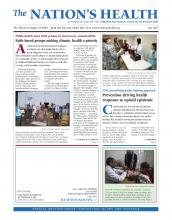Maintaining vacant properties — which can be a blight on the community and a source of numerous public health hazards — may reduce crime rates in urban neighborhoods, according to a study published in April in Applied Geography.
The study looked at the impact of a community greening program in Flint, Michigan, in relation to crime data from 2005 to 2014. It found that keeping vacant properties tidy can make a positive difference for residents, in terms of both health and safety.
“The blight itself doesn’t necessarily beget public health issues,” but such spaces “invite activities that are deleterious to health,” lead study author Richard Sadler, PhD, told The Nation’s Health.
According to Sadler, an assistant professor in the Department of Family Medicine at Michigan State University, vacant properties present a range of hazards to community members. Not only are such properties often structurally unsound, but they also tend to serve as a dumping ground for waste, and even dead animals. In addition, vacant properties, generally neglected, are visually unpleasant and do little for community morale.
Researchers analyzed the impact of the Genesee County Land Bank Authority’s Clean and Green program on crime rates using an emerging hot spot analysis, which pinpoints trends over space and time. The Clean and Green program helps community groups clean, maintain and improve the appearance of vacant properties in Genesee County. Researchers looked at the dates, location and intensity of the greening program in conjunction with dates, location and types of criminal activity in Flint to identify “hot spots” for crime.
The findings show that over time, neighborhoods with low levels of greening activity were associating with more intense and oscillating hot spots for property crimes. Meanwhile, cold spots for all types of crime were associated with higher levels of neighborhood greening. Over time, higher greening scores were more closely linked to lower rates of all types of crime.
While greening generally led to reductions in crime, the study noted that some neighborhoods in Flint overwhelmed by crime experienced an overlap in crime and greening hot spots, meaning that the effect of greening programs was less effective in such areas.
Neighborhood blight is symptomatic of larger problems in Flint, a city that has long grappled with social and economic stresses. The city is also strained by an ongoing water crisis, in which residents were exposed to dangerous levels of lead in their drinking water. Greening is a small-scale effort to rejuvenate communities that have faced hardship.
“It’s kind of unfortunate because these are people who are giving back to their community but they effectively become lawnmowers because the scale of the problem is so big,” Sadler said. “People don’t know how to deal with cities that are bleeding populations and there’s not a lot of higher-level governance that (has) afforded their redevelopment.”
However, greening could slow such bleeding, Sadler said, in a “necessary but insufficient (solution) to restore the community,” echoing a sentiment from the study.
“Given Flint’s ongoing infrastructure challenges — including a public health crisis over lead in drinking water — the city will continue to require innovative, community-building strategies if it is to provide a high quality of life for its residents,” the study concluded.
For more information, visit www.sciencedirect.com/science/article/pii/S0143622816305707.
- Copyright The Nation’s Health, American Public Health Association









